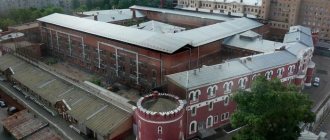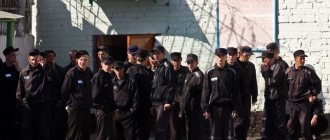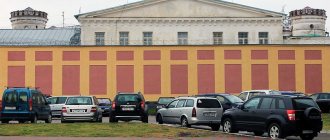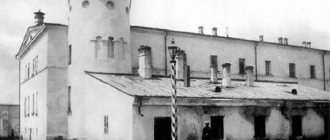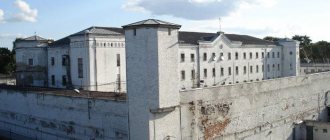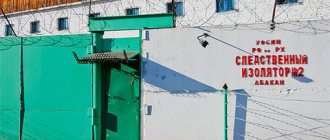The Taganskaya prison, although it no longer exists in this form, is still on the lips of many, since from just a penitentiary institution it has become, in fact, a historical place.
The official name of this place of detention for offenders is the Moscow Provincial Criminal Prison. It was built and put into operation back in 1804.
At that time, there were only three largest penitentiary institutions in the Russian Federation, and the Taganka prison was the strictest and, one might even say, tough. At different times, between 1,200 and 4,100 prisoners served their sentences there.
The most dangerous prisoners were sent to the Taganka prison, and therefore it was believed that it was almost impossible to escape from there. In fact, the penitentiary institution was a kind of analogue of the current penal colonies for especially dangerous criminals and life prisoners.
Starting from the 20th century, the Tagansk prison was “re-qualified” as a transit prison - political criminals were already kept here, that is, enemies of the people, traitors, as well as other citizens of the USSR who were undesirable to the authorities there were hidden behind the walls of the colony.
It should be noted that in just 20 years the number of political prisoners, as well as other offenders, increased almost 4 times - from 1000 to 4200. And since the walls of the penitentiary were not rubber and could not accommodate so many people “comfortably”, fires constantly broke out epidemic, and for new prisoners the place was freed up due to the pestilence. It goes without saying that few of the convicts received qualified medical care.
Shortly before the prison was closed, it was renamed the Tagansk Central Transit Prison of the Eighth Directorate of the USSR Ministry of Internal Affairs.
In 1958, most of the buildings of this historic penitentiary were demolished, but some of the buildings remained. And it didn’t just stay - eyewitnesses say that after the hurricane, voids opened up that had different directions.
The beginning of the history of the Moscow provincial criminal prison
Imprisonment as a punishment for criminal acts in Russia began to be used under Tsar Ivan the Terrible. The peak of activity in the construction and organization of correctional imprisonments occurred during the reign of Catherine II. In 1804, Emperor Alexander I issued a decree on the construction of the Moscow provincial criminal prison. The outskirts of Moscow were chosen as the location for setting up such an institution. Today this is Malye Kamenshchiki Street. The Novospassky Monastery and Taganskaya Square are very close. It was by its name that the Taganka prison got its name among the people. Initially, the institution was classified as a “prison workhouse”; prisoners lived and worked here permanently.
Brains covered with soil
First, a few comments from an article by a venerable “alternative” , which were sent to him by adherents of something that did not happen to them.
These archaeologists and scientists are amazing guys. A cataclysm occurred and nature dismantled the roofs and covered the buildings. I have always wondered what non-disclosure documents they sign, that they do not tell the truth either officially or in “kitchen” gatherings...
And it all fell from the sky until the 20th century. No matter how many times I look at old photos, I see one feature everywhere. In all countries, men and women, rich and poor - everyone wears hats. Even street children, barefoot - but wearing hats. The other day I listened to a couple of books by French authors of the 19th century. They describe the life of rich people and their walks. Even in extreme heat, they did not risk taking off their gloves. Because they were afraid that if they were on the street without gloves all day, they simply might not wash their hands of dirt, and the dirt was in the air. And this is in the center of Paris. And then I suddenly thought: a veil and a burqa are stupid protection for the respiratory system from dust. Veil for women in Europe, Russia, America. For men, a big mustache. And so it is everywhere.
The key phrase is “... and so everywhere...” And where exactly? In their opinion, the consequences of this scourge are found everywhere in all our cities.
Particularly striking is the thought about the mustache!!! :-) which protected men from the corrupting influence of heavenly destruction, and logically not only them :-)
Victim of a flooded brain
Not everyone knows, but Miyazaki would be aware of the tragedy of “alternative” liberalism in history. And he tried to tell us, but not everyone understood him.
Victims of the brain carried by the flood
Let's look at the evidence of the flood, which is somewhere near us. And where? It’s not clear yet, but a brain trained to deal with buildings buried by a flood will find a solution. This is about a different brain :-) The author of this article.
Here it is! Revelation of Sibved!
Assess the ground level inside the yards. Clay color. Road work (there was no dumping here) probably took place. And the buildings are covered up to the windows.
Buildings covered by the flood Continuation of the view to the right
This is one courtyard. I tried to combine the photos, it turned out like this. A little crooked, but understandable.
Buildings destroyed by flood
What kind of buildings are these? And in general, what is the place that was swallowed up by the flood and where are the traces of this event? Where are the pipes laid near the left house? Have you dug a trench and don’t understand that they are about to open it? What?
In a worldwide conspiracy of archaeologists and historians, of course.
“... Road work (there was no backfill here) probably took place...” (c) Sibved.
The key word is “... do they lie... “.
What kind of building is this, damaged by brains covered with soil? Over there, on the right.
In the densely populated Taganka quarter, densely surrounded on all sides by residential buildings and kindergartens, stands this pleasant pre-revolutionary building. It was built in 1908, if you haven’t seen it, then you’ve definitely heard about it - this is the last surviving building of the famous Taganskaya prison complex. An administrative building was once located here (according to other sources, in addition to the jailers’ offices, female prisoners were kept in part of the building). – https://zen.yandex.ua/media/moskvadetaly/vse-nochi-polnye-ognia-kak-naiti-poslednee-ucelevshee-zdanie-znamenitoi-taganskoi-tiurmy-5e0065d778125e00aea0a191
Taganskaya prison
The Moscow provincial criminal prison, Taganskaya prison or simply “Taganka” was built in 1804 by decree of Emperor Alexander I. It was located on the then outskirts of Moscow, not far from Taganskaya Square (from which it received its name), on Malye Kamenshchiki Street (modern possessions 16 and 18), in close proximity to the Novospassky Monastery. Demolished in 1958. – Wikipedia
This is how it was here before. Our building is to the left. Behind the scenes. He is not visible.
https://pastvu.com/p/7724
And here it was like this.
Taganskaya prison https://pastvu.com/p/948435
This is the prison courtyard. The administrative building we are looking at is behind this building.
And this is what it all looks like now:
Buildings destroyed by flood
Again:
“... Road work (there was no backfill here) probably took place...” (c) Sibved.
Like this? What about the construction of the buildings themselves? What about explosive work to destroy prison buildings?
But, alas :-) This was only in 1958, and what we see is 1954! BUT!
Diagram of buildings destroyed by the flood
It’s not visible on a smartphone, I’ll probably explain:
- B&W photo – 1958, before the prison was demolished. The red building is on the left, part of it is visible, on the right is the prison fence. The alley slopes upward; it goes out onto Little Masons Street.
- CV photo - 1954, Behind the red building, straight ahead, is the yellow prison building, which in the black and white is located on the right behind the fence.
Got it? :-) Master class on city orientation :-))
What is the point of the master class?
Who was kept and re-educated in the legendary prison?
Initially, Taganka was intended for criminals. However, already in the 20th century it received the status of “transit”, and in the 21st century. Political prisoners were also placed here. The explanation for such changes is the simplest. Other Moscow prisons, Butyrka and Matrosskaya Tishina, did not always have enough places for new prisoners. Since its founding, the Moscow provincial criminal prison has had a huge number of workshops. None of the prisoners were left without work, and if the convict did not have any profession, he was also trained while serving his sentence. Right on its territory, the Tagansk prison had metalsmithing, blacksmithing, mechanical, tailoring, turning, printing and bookbinding workshops. Already in 1921, the newspaper Pravda praised the competent organization of re-education of convicts through labor and highly appreciated the importance of the work of prisoners for society and the country. Meanwhile, in 1920, only about 1,200 convicts were kept in Taganka, and just under 200 people were employed.
Instead of a preface
| While watching the most popular animated series of all time, “Well, wait a minute!” with the kids, in its 18th episode I heard a familiar tune. Wow! A thug-like song was included in the most famous cartoon filmed by Vyacheslav Kotenochkin at the height of democracy (1993) and in an episode dedicated to the memory of Anatoly Dmitrievich Papanov (the role of a wolf)!?... Singing this melody, it was decided to present this short essay on the World Wide Web. |
Chapter 1. About the Taganskaya prison or this street, this house...
Every city has its own legends or myths. Moscow is no exception. It happens that what they were originally dedicated to has long since disappeared, but the legends themselves live on, are translated into poems and songs, and multiply. A similar story happened with the Tagansk prison, thanks to which, long before 1964 (the year the famous Taganka Theater was created), all of Russia knew about one of the districts of the capital. The word “Taganka” was strongly associated with this prison and everything connected with it for many years. In total, in Moscow in the 19th-20th centuries there were three large prisons - the central transit prison (Butyrskaya), the correctional prison (on Matrosskaya Tishina) and the provincial one, also known as Taganskaya. Moreover, the Taganskaya prison was the most famous and most serious in Moscow; it was impossible to escape from it. Taganka was also the champion in the number of songs dedicated to “state houses with a checkered sky.” Here's what you can read about it in reference books:
| Taganskaya Prison (Moscow Provincial Criminal Prison) was built by decree of Alexander I in 1804 near Taganskaya Square (Malye Kamenshchiki, 16). Initially, only criminals were kept there, but from the end of the 19th century. - and political. The main function is a “custodial workhouse.” The prison had workshops: tailoring, metalsmithing, blacksmithing, turning, bookbinding and a printing house. After the October Revolution, urgent orders were carried out in the workshops of the prison for the central punitive department of the People's Commissariat of Justice, internal security troops and internal service. In July 1920, the prison staff consisted of 191 people, there were 1,200 prisoners. 500 people were employed in workshops and external work alone, 56 worked in the printing house and bookbinding (TsMAM. F. 2244. Op. 1. D. 10. L. 9, 16 - 19 vol.). The buildings of the Taganskaya prison were dismantled in the mid-1950s. In its place four five-story buildings were built. (Moscow: Encyclopedia. M., 1980. P. 589 - 590; Forty forty... P. 545 - 546). |
Built for criminals, Taganskaya prison at the beginning of the 20th century.
It also becomes a place of detention for political prisoners and businessmen disliked by the government. The list of famous figures of Russian history who visited Taganka alone could fill a whole brochure. Among the “tenants” of “Taganka” there were such outstanding personalities as Savva Morozov, Pavel Florensky, Leonid Andreev and many many others. You could write a multi-volume novel about the prison itself. We will cite only a few “pages” from this still non-existent work. Prison songs were written about Taganka, and in Taganka itself they wrote songs of freedom, songs of revolution. In Taganka the song “Bravely, comrades, keep up!” was composed. (words by L. Radin, 1897). The text was written during Radin’s stay in Tagansk prison in the case of the Moscow “Workers’ Union”; the arrest was made on the night of November 10-11, 1896. At the end of February 1898, before being sent to Siberia, a group of prisoners learned this song from the words of the author to the tune of the old student song “Time Moves Slowly” (verses by Ivan Nikitin); This motive was changed by L. Radin to the rhythm of the march. In March 1898, L. Radin’s song with the same motive was sung by prisoners of the Butyrka transit prison. The further dissemination of the song was facilitated by its numerous publications. It was one of the most popular Red Army songs during the Civil War. Also, “Boldly, comrades, in step” served as the basis for new revolutionary songs and songs of the Civil War: for example, “The People’s Will is Done” during the February Revolution of 1917, “Friendly, comrades, in step” during the Civil War. Anarchists can sing: “And we will hoist the Black Banner of Labor over the earth.” A professional revolutionary, a prominent figure in the Bolshevik Party, Bauman N.E. was sitting in Taganka. (party pseudonyms: Grach, Poletaev, Sarafsky, Sorokin). The famous actress M. Andreeva, with the money of her lover, millionaire Savva Morozov, prepared the escape of members of the Bolshevik Party from Tagansk prison. In February 1905, her brother, the famous writer Leonid Andreev, was imprisoned in Tagansk prison for 16 days. He was accused of holding a meeting of the Central Committee of the Russian Social Democratic Labor Party, which was outlawed at that time, in his house and with his consent. A deposit of 10,000 rubles, at the request of M. Gorky, made by Savva Morozov, allowed Andreev to go abroad, to the wonderful island of Capri, to visit the first proletarian writer. In January 1906, in Tagansk prison, having agreed with the administration, F.I. Chaliapin sang for the prisoners. For the sermon “The Voice of Blood,” dedicated to the memory of the executed Lieutenant Schmidt and read at the Moscow Theological Academy in March 1906, P.A. Florensky served seven days here. Revolutionary businessman L. Krasin spent 10 months behind bars in Tagansk for participating in the work of Marxist circles, having studied the German language perfectly. Another, no less famous Bolshevik A. Lunacharsky received four months of solitary “prison time” in Taganka. Savva Mamontov was kept in solitary confinement for more than five months with the assistance and at the request of Tsarist Prime Minister S. Witte. The term would have been several times longer, but the Moscow Art Theater members, the employees of the Northern Railway, the famous lawyer F. Plevako and others, who were kind to him, raised their voices for the patron. The famous “adventurer of the 20th century” V.F. Trakhtenberg drank gruel here in 1908 - this is his real name, not a pseudonym! - who, not having a clear idea about the Moroccan mines, contrived to sell them to the French government (P. Severyanin. Adventurer of the Century. Quoted from: V. Kozlovsky I, 223). Wasting no time, Trachtenberg, who was not a professional lexicographer, compiled the “Dictionary of Thieves’ Speech” behind bars, which for decades became the basis for all subsequent dictionaries of thieves’ jargon and many other linguistic works of this kind. It so happened that all subsequent “compilers” simply rewrote his dictionary as the most famous and popular, then put their name (on the title page) and submitted the book to print. The traditions of plagiarism in the field of lexicography were established precisely in 1910-1920. V. Lebedev's dictionary (1909) is a slightly expanded “Trachtenberg”; bailiff V.M. Popov (1912) borrowed everything from Lebedev, and S.M. Potapov (1923) - from Popov. Subsequent compilers, as a rule, used the dictionaries of Popov (1912), Potapov (1927) and some others. Thus, the entire tradition of compiling dictionaries of Russian thieves' jargon goes back to V.F. Trachtenberg. Yes, by the way, of course, everyone knows the word “gruel”. But one of the versions of its origin is connected specifically with Taganka:
“...before the revolution, there was a chef in the Tagansk prison named Balandin. He was a terrible cook: kharcho soup - just some water. Well, the urks rebelled and boiled this Balandin alive in a cauldron. This is where it came from - gruel, balander (food distributor)... So that the cook does not forget what can await him..."
From May 13 to August 11, 1908, a group of deputies of the first State Duma served their sentences in this prison. Princes Trubetskoy and Dolgorukov stood up for them, but the rest of the noble part of the Duma assembly showed “class consciousness” and agreed to the arrest of their former colleagues. For six months, the humanist writer L. Osorgin “sweated” on the Tagan bunks for propaganda work in the ranks of the Socialist Revolutionary Party. Another Socialist Revolutionary, 19-year-old V. Mazurin, was less fortunate: according to the verdict of a military court for murder and robbery on the night of September 1, 1906, he was hanged in the basement of Taganka.
After the October Revolution, Taganka became one of the “outposts” of the struggle for a new life. Thousands of nobles, clergy, members of parties competing with the Bolsheviks, victims of Stalinist repressions flowed in an endless stream into the dungeons. The prison church was turned into a club. Services were held in a large cell converted into a communist school during free time from classes. At the same time, prayers were read under portraits of Lenin and Trotsky, which the authorities did not allow to be removed even during the ceremony. The worshipers were guarded by volunteer guards from among the old-time believers. The house prison church of the Recovery of the Dead, built in 1894 with the money of A.D. Rastorguev (25,000 rubles), was closed in 1922. In the early 1920s. in prison, the appearance of respect for civil rights was observed, since from time to time foreign humanitarian delegations visited Taganka. One day, a parcel with sheepskin coats from E. Peshkova, Gorky’s ex-wife, sent through the Red Cross, was brought to the Tagansk prison. Although all this did not stop investigators from knocking out prisoners’ teeth during interrogations, breaking ribs, arms, legs, and cervical vertebrae. The head of the prison was the brother of the wife of the famous revolutionary Menzhinsky. Oddly enough, the prisoner priests remembered this chief with a kind word and told with emotion how, having learned about the authorities’ decision to arrest Patriarch Tikhon, he secretly came to His Holiness at night, asked for a blessing and warned about the arrest. Hieromartyr Maxim (M. Zhizhilenko) previously worked as the chief physician of the Tagansk prison. Having lost his wife during childbirth, he devoted himself to serving prisoners: he slept on bare boards, ate from the prison boiler, and gave money to the “inmates.” Having later become the Bishop of Serpukhov, he came to the attention of the authorities, was arrested and soon shot. From November to December 1937, the security officers tormented with interrogations St. Seraphim, an 82-year-old, bedridden elder who was taken to prison in an ambulance. Having failed to obtain a confession from the ruler, the guardians of the law took him from here to Butovo and shot him at a special training ground. Scientists and luminaries, full members of the USSR Academy of Sciences Kravets and Leibenzon, also shared a common cup with the Tagansky criminals. The main prototype of the famous Ostap Bender (in life - Ostap Shor) in 1922 also ended up in a Tagansk bunk for a fight and ate local gruel. But, having learned that he had previously served in the Odessa criminal investigation department (under Soviet rule, of course), the prison authorities released him. Remember:
“But I still think that you know me. - I don’t recognize. But the stranger’s gaze was so pure, so clear that the administrator’s hand itself allocated two seats for Ostap in the eleventh row. “There are all sorts of people walking around,” the administrator said, shrugging his shoulders, to the next brainiac, “who knows who they are... Maybe he’s from the People’s Commissariat for Education?.. I think I saw him in the People’s Commissariat for Education... Where did I see him? And while mechanically handing out passes to happy theater and film critics, the quiet Yakov Menelaevich continued to remember where he had seen those pure eyes. When all the passes were issued and the light in the foyer was dimmed, Yakov Menelaevich remembered: he saw these clear eyes, this confident look in the Taganskaya prison in 1922, when he himself was imprisoned there on a trivial matter.” (Ilya Ilf and Evgeny Petrov “Twelve Chairs”) The newspapers of that time wrote about the humane educational significance of prisons: “At the punitive department of the People’s Commissariat of Justice, from May 15, on the initiative of Comrade Savrasov, shock brigades were organized from prisoners of the Tagansk prison to repair sewerage, water supply, electric lighting and other works. This work is currently being carried out in places of detention and in the Yauza hospital under the leadership of engineer Korolenko. Next up is a question of enormous importance - that these workshops be expanded into various branches of production and reach the factory model, and that not a single prisoner leaves prison without studying some branch of production" (Pravda, 02.11.1921) . In the same year, the magazine “Prison”, published in the Taganskaya prison, joyfully told readers that “the work of prisoners is becoming increasingly important.” Although only 65% of prisoners worked in the Tagansk provincial prison at that time. The life of the Taganskaya prison did not differ in any significant way from the life of the cells of another Moscow prison - Butyrskaya, only everything here was second-class: lunches, dinners, a “bench”, a dirty restroom, and a bathhouse. No, the bathhouse was not even second-class, but something worse. The bathhouse in Butyrka was a holiday, the bathhouse in Taganka was a punishment. For some reason, the camera was always taken to the bathhouse in the middle of the night. I had to tie all my things in a knot into a blanket and, in addition, carry mattresses with me - I relied on one for two. In the bathhouse, mattresses and bundles of things were handed over for disinfection, and we were driven into a narrow, cramped and cold dressing room, which could only accommodate about forty people, but into which they squeezed all seventy. The prisoners undressed in incredible cramped conditions, their clothes and underwear were also handed over for disinfection: they were not supposed to wash their clothes in this bathhouse. There were no buckets or taps with water, there were about fifteen showers, and five people were washing under each at the same time. And then - the agony of getting underwear and clothes, the agony of getting dressed amidst the wild crush, the agony of sorting out the untied blanket bundles with things. Exhausted by all this, the prisoners returned to their cell in the morning (from the book of Ivanov-Razumnik R.V. “Prison and Exile”, 1953) In 1940, there were 4,120 prisoners in the Taganskaya prison, the percentage of party cadres among them increased immeasurably. A striking example is the fate of the prisoner Kedrov. One of the leaders of the security agencies, who participated in the undermining of the Taganskaya prison in 1904 and joined the party in the same year, was arrested in 1939 and spent two years in an internal NKVD prison. In July 1941, the impossible happened - he was acquitted. But you cannot escape fate, and the old Bolshevik, who even among the security officers was known as a cruel man, was killed on the personal orders of Lavrentiy Beria. In Taganka, S. Kovalenchik was shot, a man with a similar fate - a participant in the Civil War, a member of the Revolutionary Military Council of the 15th Army, and in recent years an agricultural scientist. Due to a misunderstanding, in 1942, Daniil Kozhubergenov, a liaison officer of political instructor Klochkov, who miraculously survived a heroic battle with fascist tanks at the Dubosekovo crossing, ended up in Tagansk prison in Tagansk prison. For a long time, the Panfilov hero’s point of view on some episodes of the war was “changed.” Then they were sent to a penal battalion. General Vlasov and his henchmen, who unsuccessfully asked to be shot as soldiers, were hanged in the courtyard of the Tagansk prison in August 1946 by a court verdict. In February 1951, before being deported, the famous healer Porfiry Ivanov was held in the Tagansk prison.
If the archival files of prisoners were still intact, in many of them one would see the phrase “repressed, shot (or hanged) in Tagansk prison.” Before the demolition, the Taganskaya prison was a six-story brick, yellow building, inside of which there were galleries fenced with metal mesh to prevent suicide attempts. The outer walls were also generously “decorated” with barbed wire. Above the large gate hung a sign “Ministry of Internal Affairs of the USSR. EIGHTH DIRECTORY. CENTRAL TAGANSKAYA TRANSFER PRISON." And the Tagansk prison was blown up in 1958 during the Khrushchev Thaw. The four-story prison building was destroyed, as Vladimir Vysotsky sang in one of his songs:
“They broke the old Taganka, clean and to hell!..”
| Although the old-timers of this Moscow quarter still remember the high walls with barbed wire, the evening and morning riots, and sometimes even the sounds of gunfire... All this is no longer there. The only reminder of the old prison is this practically unremarkable office building, lost somewhere in the depths of the courtyards along Malye Kamenschiki Street. |
On that site, a kindergarten and residential buildings for employees of the Ministry of Internal Affairs were built - four five-story buildings - especially for Taganka security guards.
It was believed that in a few years communism would come, and only wild animals would be behind bars in the USSR. But in the minds of Muscovites of the older and middle generations, the very word “Taganka” still causes heightened anxiety. In the post-war years, Tagansky hooligans were considered almost the coolest in Moscow. Taganka - prison - nights full of fire. Here is a small gentleman's set of associations reflected in urban folklore. If you find yourself in Moscow and want to visit Taganka, or more precisely the place where it was, then find the route of the 26th trolleybus, which takes you to the Ulitsa Gvozdeva stop. Novospassky Lane goes to the left. It doesn't seem like anything special. There are many trees, the river looms ahead. On the even side - just on the hill of the five-story building at number eighteen. So they were built on the site of the Taganka. There are many amazing stories and legends about these places. Local residents say that under these five-story buildings there are “catacombs”, secret passages and loopholes that were once used by prisoners. They also talk about prison basements that have been preserved under houses, but the entrances to these basements are tightly sealed. They also remember the hurricane of 1998, when large human bones were found in holes left after uprooted trees. Here, such a “Taganochka”... But Taganka, of course, is not only a prison.
Legends and facts
Tagansk prison has seen many broken destinies and people convicted unjustly. The history of this correctional institution is full of various legends and facts, which are not at all easy to believe. At one time, Menzhinsky’s brother was the head of the prison, and surprisingly the prisoners really liked him. They say that when he was informed about the planned arrest of Patriarch Tikhon, he personally came to His Holiness and, asking for a blessing, reported the detention. However, perhaps all this is just a beautiful myth. And yet, life was very good for someone in the Taganskaya prison. After the revolution V.F. Dzhunkovsky, the former governor of the Moscow region and head of the police, found himself in Taganka as a prisoner. The attitude towards this prisoner was very lenient. The whole point is that Dzhunkovsky was a well-educated and intelligent person; as an exception, he was allowed to raise children and also raise rabbits; soon, however, he was completely released. An interesting life story is that of Maxim Zhizhilenko, the son of a prosecutor who worked as the chief physician in a correctional facility. The Tagansk prison truly became a home for him. After the death of his wife, he led the life of an ordinary prisoner - he lived in a simple cell and ate food prepared for prisoners.
Court and case. Blog of lawyer Irina Krasnova
Hello dear readers!
If you think that I am only delving into the laws, then you are deeply mistaken. I also really like to wander around Moscow and look for something interesting.
So, do you know where Taganskaya prison is? Or rather, what is left of it?
And here she is.
The administrative building of the Taganskaya prison is almost all that has survived.
In general, imprisonment in Russia arose under Ivan the Terrible, but prisons themselves began to be actively built under Catherine II.
And Taganskaya was built already in 1804. It turns out that she is a little younger than Butyrka, but older than Matroska and Lefortovo. Moscow provincial criminal prison.
But let's return to modern times. To the left of the entrance hangs this curious sign: a trust, just a trust.
And who was sitting in it? And there are many personalities known to us. For example, at the beginning of the last century, the adventurer Trachtenberg was a prisoner of Taganka, who sold non-existent Moroccan mines to the French government. He later compiled a dictionary of thieves' jargon, which is still known to us today.
And also, from here, from Taganka, the name “Balanda” came from. The cook Balandin, famous for his disgusting cooking, worked in this prison. As a result, the prisoners cooked him in a pan of borscht. Apparently they ate it. Don't throw away the product.
Here, in Taganka, the song “Bravely, comrades, keep up!” was written. The revolutionary Krasin did not waste his time and, while serving his sentence, learned the German language perfectly. Lunacharsky also honored this prison with his imprisonment. Savva Mamontov also suffered here for helping the revolutionaries.
“There are all sorts of people walking around,” the administrator said, shrugging his shoulders, to the next brainiac, “who knows who they are... Maybe he’s from the People’s Commissariat for Education?.. I think I saw him in the People’s Commissariat for Education... Where did I see him? And while mechanically handing out passes to happy theater and film critics, the quiet Yakov Menelaevich continued to remember where he had seen those pure eyes. When all the passes were issued and the light in the foyer was dimmed, Yakov Menelaevich remembered: he saw these clear eyes, this confident look in the Taganskaya prison in 1922, when he himself was sitting there on a trivial matter
Yes, yes, the prototype of Ostap Bender (Osip Shor, a criminal investigation officer) also occupied a cell in Taganka for some time.
After the revolution, the Moscow governor and former head of the Moscow police V.F. Dzhunkovsky was also sent to Taganka, where he, as a very highly educated and intelligent person, bred rabbits and raised young children. At the end of the 20s, he was finally released to help create a passport system. It turns out that he is one of the authors of the system, thanks to which collective farmers were left without passports. At first, as a former officer, he was even given a pension. But, of course, he was shot in 1937.
Prison inmates participated in the construction of the Moscow water supply, sewerage and electrification, which was joyfully reported by the Taganka magazine “Prison”: “The labor of prisoners is becoming increasingly important.”
Vlasov and his entourage were hanged by a court verdict (they were hanged, not shot) in the courtyard of the Tagansk prison. The head doctor of the prison, Maxim Zhizhilenko (son of the prosecutor, by the way), led the life of an ordinary prisoner. He lived in a cell and ate with everyone from a common pot. It’s hard to imagine something like this now, isn’t it?
Porfiry Ivanov, a famous healer, (who promoted dousing with water) was here before the transfer (at that time it had already become a transfer).
Conditions in Taganka were terrible. For example, a shower intended for 7 people was filled with 40.
In addition to the administrative building, the prison washing machine has also been preserved. Here it is (now it has a housing office)
The prison was blown up in 1958. And in its place they built a kindergarten and houses for the employees of that prison. Here they are.
“They broke the old Taganka completely and to hell!..” sang V.S. Vysotsky.
In the photo on the left, the Novospassky Monastery is the tomb of the Romanov family. The mother of the first king of the Romanov family, nun Martha, is buried there. After the revolution, the monastery ceased to be a monastery, but became a branch of the Tagansk prison for foreigners. And an underground passage led to the main Taganka. I was looking for traces of this move, but alas(((But, the local residents probably found something. Well, in the photo on the right is a house built for NKVD employees.
By the way, who wrote the song: “...Tagankaaaa, why did you ruin me...”?
Share on social media networks
0
Tweet
"Taganka" in the 20th century
After the 1917 revolution, all Russian prisons were overcrowded with a “new” type of criminal - political prisoners. The next wave of arrests affected religious figures. Interestingly, a church was built in Taganka (1894), but already in 1922 it was closed. Then the religious prisoners received the premises of a communist school for their meetings. It was necessary to pray in front of the portraits of Trotsky and Lenin, fortunately there were volunteers from the staff who agreed to guard the prisoners during this event. Another interesting fact: in 1940, the Taganka prison housed 4,120 prisoners, but there were less than 800 staff. In 1946, an unusual execution took place right in the courtyard of the legendary correctional institution. General Vlasov and his followers died by hanging; there is evidence that the condemned themselves asked to be traditionally shot “like soldiers.”
Recommendations
- ^ a b c d
Katrina Marie, "Taganka: Ghosts of the Intelligentsia and Blue-Collar Grit"
Passport Moscow
. Retrieved December 5, 2011 - Figes, Orlando: A People's Tragedy: The Russian Revolution 1891–1924.
. Bodley Head, London (2014). pp. 195–196 - Avril Payman, Pavel Florensky: Quiet Genius: The Tragic and Extraordinary Life of the Russian Unknown Da Vinci
Continuum International Publishing Group (2010), p. 55. ISBN 978-1-4411-8700-0 Retrieved December 5, 2011 - "Thomas Sgovi" History of the Gulag / Roy Rosenzweig Center for History and New Media, George Mason University. Retrieved December 5, 2011
Prison jargon and “thieves’ romance”
Interesting fact: the first dictionary of prison jargon in Russia was compiled in Taganka. V. Trakhtenberg carried out a colossal amount of work, the result of which was a unique collection of “translations” of criminal slang into the Russian literary language with explanations and comments. A popular version is that the word “gruel” also appeared in this prison. Legend has it that once upon a time a cook with the surname Balandin worked in the local kitchen, who managed to prepare practically inedible dishes for prisoners. As a result, his creation was nicknamed “gruel”, and the chef himself was cooked in a saucepan with yet another inedible soup.
Famous prisoners
Over the century and a half history of this correctional institution, a huge number of famous and simply outstanding people have visited it. At various times there were: N. Bauman (Bolshevik revolutionary), V. F. Trakhtenberg, Savva Mamontov, Porfiry Ivanov (famous healer), Osip Shor (prototype of Ostap Bender), Kravets T. P. (academician) and many others . In fact, this list can be continued indefinitely. It is worth noting that life in prison was often the same for everyone. Intellectuals, politicians and religious leaders lived in conditions created for criminals and were often involved in hard work.
Taganka (prison)
| This section is an unordered list of various facts about the subject of the article. Please bring the information into an encyclopedic form and distribute it to the appropriate sections of the article. As decided by the Wikipedia Arbitration Committee, lists should preferably be based on secondary, aggregated authoritative sources that provide criteria for inclusion of items in the list. |
| The section lacks links to sources. Information must be verifiable or it may be deleted. You can |
In the Tagansk prison, the poet Leonid Radin wrote the famous song “Bravely, comrades, keep up!”
The prominent Bolshevik revolutionary N. Bauman was in prison.
The famous actress, common-law wife of Maxim Gorky M. Andreeva, with the money of Savva Morozov, prepared the escape of several Bolsheviks from the Tagansk prison. In February 1905, her good friend, the famous writer Leonid Andreev, was imprisoned in Tagansk prison for 16 days. He was accused of providing his apartment for a meeting of the Central Committee of the RSDLP. A deposit of 10,000 rubles, made by Savva Morozov at the request of M. Gorky, allowed Andreev to go abroad.
For the sermon “The Voice of Blood,” dedicated to the memory of Lieutenant Schmidt and read at the Moscow Theological Academy in March 1906, P. A. Florensky served seven days here.
Revolutionary businessman L. Krasin served 10 months, learning German. The future People's Commissar of Education, A. Lunacharsky, spent 4 months in prison[2]. M. A. Savelyev spent 11 months here[3].
Millionaire Savva Mamontov was in solitary confinement for more than five months for helping revolutionaries.
The Socialist-Revolutionary Maximalist V. Mazurin was hanged in the basement of Taganka after being sentenced by a military court for murder and robbery in September 1906.
The 20th century adventurer V.F. Trakhtenberg drank gruel here in 1908, who, not having a good idea about the Moroccan mines, contrived to sell them to the French government. Trachtenberg, not being a professional linguist, compiled a dictionary of thieves' speech while behind bars, which became the prototype of all subsequent similar dictionaries.
From May 13 to August 11, 1908, a group of deputies of the First State Duma served a three-month sentence here for the so-called “Vyborg Appeal.” This is how Moscow Governor V.F. Dzhunkovsky describes this event:
All convicts received summonses that day to appear at their stations, from where they were transported to the provincial (Tagansk) prison. Only one of the Vyborg residents - Prince S. D. Urusov, probably as a former comrade of the minister, the bailiff himself came to the apartment and took him directly to prison. Those brought were G. F. Shershenevich, Prince Pyotr Dolgorukov, V. E. Yakushkin, M. D. Lebedev, M. G. Komissarov, F. F. Kokoshkin, A. R. Lednitsky and V. S. Nechaev. At the prison gates, a crowd of fans brought them flowers and expressed signs of sympathy. Then they brought Savelyev[4] and Sadyrin, the last was S.A. Muromtsev [chairman of the dissolved Duma], the crowd gave him a standing ovation and presented him with a bouquet[5]
Letter from the “Vyborg” deputies of the First State Duma to deputy Prince S. D. Urusov, who did not participate in the meeting of a group of deputies in Vyborg after the dissolution of the Duma, but voluntarily appeared in court, declaring solidarity with the Vyborg Appeal:
“Tagansk prison, July 5, 1908
Dear comrade!
We are happy about the Day of your angel, we are glad to tell you how high you stand in our eyes, how close you are to us, how dear, how tender feelings we have for you. You are here only because you wished to share common hardships, common responsibility. The months of prison gave us the opportunity to get to know each other, and at this moment we don’t want to talk about anyone else, only about you, about us. We are not saying how Russian society should and, undoubtedly, treats you. Today we greet you, your co-prisoners, co-arresters. You wove it into a wreath
traditions of the aristocratic family, the memory of prison as a reward for the people's choice! It will powerfully tell future generations that at certain moments the people’s representative does not dare think about himself!
On behalf of the Vyborg prison colony, the head of the Vyborg wing, A. Lednitsky.”
Wreath theme
for the same Vyborg residents, it unexpectedly surfaced in the history of the Tagansk prison after the revolution. As the same Dzhunkovsky writes:
After the coup in February 1917, during the time of Kerensky, the cell in which Muromtsev was kept was repaired, and in memory of S. A. Muromtsev’s stay in it, his portrait, decorated with a silver wreath
from prison supervision funds. Subsequently, already in 1921, while I was being held in the Tagansk prison, this wreath was stolen, which caused a great stir. The culprit was never discovered, but after some time the wreath was found and kept after that in the prison governor’s office[6].
After the announcement of the “Red Terror”, many nobles, clergy and merchants were sent to Taganka. The prison church became a club. Services were held in a large cell converted into a communist school. Prayers were read under portraits of Lenin and Trotsky. The worshipers were guarded by volunteer guards from among the old-time believers. The house prison church of the Recovery of the Dead, built in 1894 with the money of A.D. Rastorguev, was closed in 1922.
In the early 1920s. in prison, the appearance of respect for civil rights was observed, since from time to time foreign humanitarian delegations visited Taganka. One day, a parcel with sheepskin coats sent through the Red Cross from E. Peshkova, Gorky’s ex-wife, was brought to the Tagansk prison.
Hieromartyr Maxim (M. Zhizhilenko) previously worked as the chief physician of the Tagansk prison. Having lost his wife during childbirth, he devoted himself to serving prisoners: he slept on bare boards, ate from the prison boiler, and gave money to the “inmates.” Having become the Bishop of Serpukhov in Soviet times, he was arrested and executed on June 4, 1931.
From November to December 1937, Saint Seraphim, an 82-year-old, bedridden elder, was kept in prison. Having failed to obtain a confession from the priest, he was shot at the Butovo training ground.
Scientists - full members of the USSR Academy of Sciences T. P. Kravets and L. S. Leibenzon also shared a common cup with the Tagansky criminals.
The prototype of Ostap Bender (in life - Osip Shor, an employee of the criminal investigation department) also ended up in Taganka for a fight in 1922, but he was soon released.
One of the leaders of the security agencies, M. S. Kedrov, who participated in the undermining of the Taganskaya prison in 1904, was arrested in 1939 and spent two years in the same prison. In July 1941 he was acquitted. But you cannot escape fate, and the old Bolshevik, who even among the security officers was known as a cruel man, was killed on the personal orders of Lavrentiy Beria. In Taganka, S. Kovalenchik, a man with a similar fate, was shot - a participant in the Civil War, a member of the Revolutionary Military Council of the 15th Army, and in recent years an agricultural scientist.
Before his execution, one of the initiators of the “Red Terror”, Martyn Latsis, a former member of the Cheka board, was sent to Tagansk prison.
Due to a misunderstanding, in 1942, Daniil Kozhubergenov, a liaison officer of political instructor V. G. Klochkov, who survived the battle at the Dubosekovo crossing, ended up in the Tagansk prison in Tagansk prison.
A. A. Vlasov and his entourage, who asked to be shot as soldiers, were hanged in the courtyard of the Tagansk prison in August 1946 by court verdict.
In February 1951, before being deported, the famous healer Porfiry Ivanov was held in the Tagansk prison.
End of story: demolition of Taganskaya prison
In 1938, the NKVD carried out a reform, as a result of which prison No. 1 OMZ UNKVD of the Moscow region became the Taganskaya prison of the GUGB. Accordingly, the correctional institution is transferred from the department of the NKVD Administration to the subordination of the Main Directorate of State Security of the NKVD. In 1939, Taganka officially changed its status and became a transit prison. In 1946, the USSR Ministry of Internal Affairs was formed. Accordingly, after several reforms to merge and distribute powers between this ministry and the KGB, the correctional institution becomes subordinate to the Ministry of Internal Affairs. The last official name of “Taganka” is the Central Tagansk transit prison of the Eighth Directorate of the USSR Ministry of Internal Affairs. The history of this correctional institution ends in 1958. The legendary prison was demolished by order of Nikita Sergeevich Khrushchev.
The harsh history of Moscow's most famous prison
“Taganka” was called the Russian and then the Soviet Bastille; the most terrible and implausible legends circulated about it
Subscribe and read Express Newspaper in:
Only old-timers of Moscow can indicate the location of the demolished Taganskaya, or Moscow provincial criminal prison, where, according to lines from a popular prison song, “youth and talent perished.” The legendary prison also gave the world the word “gruel”. Balandin cooked in the Taganka canteen . He cooked so disgustingly that the concoction received his name, and the author was cooked by prisoners in a vat of horse meat soup.
In-service release
Two centuries ago, Malye Kamenshchiki Street on Taganskaya Square was a remote outskirts. It was considered the most suitable for the construction of a prison, progressive by the standards of the 19th century.
Since the founding of the fort in 1804, the casemates housed a large number of sewing, blacksmithing, turning and even printing workshops. Chaliapin himself sang for prisoners and the administration in 1906 . This Russian prison has never known a shortage of prisoners.
Taganskaya prison. YouTube frame
New power - old prison
After the communist victory, all prisons were again overcrowded. The cells, capable of holding up to 7,000 prisoners, were filled with prominent and lesser political and religious figures. “Taganka”, which thundered throughout the country for its methods of turning criminals into hard workers, became famous for its overcrowded cells, poor nutrition and exhausted work.
Influenza and tuberculosis spread among the prisoners. The situation was aggravated by the fact that prisoners could walk around the prison without restrictions, freely visiting fellow sufferers in other cells.
A little later, conditions improved, and, according to rumors, many poor people committed petty crimes just to get into Taganka and not die of hunger on the street. The prison has regained its status as an exemplary institution. The administration even proudly hosted foreign delegations within its walls. The newspaper “Voice of Taganka” was published and broadcast on the radio, and prisoners had the opportunity to make rationalization proposals for the organization of their daily work in the workshops.
Taganskaya prison. YouTube frame
Permanent prisoner
The prison has seen many famous prisoners and twisted destinies. The walls of casemates subordinate to the NKVD often united both executioners and victims under one roof.
Nikolai Bauman , Bolshevik sponsor philanthropist and industrialist Savva Mamontov were here . For an angry speech dedicated to the deceased Lieutenant Schmidt Pavel Florensky was sent to Taganka for a week .
Pavel Florensky. Source: wikipedia.org
And after the revolution, which Florensky welcomed, five of his colleagues - senior bishops - were imprisoned. The 80-year-old elder Saint Seraphim . Later, he was shot at the notorious Butovo firing range, adding to the list of New Martyrs and Confessors of Russia who ended their lives there.
Leonid Andreev briefly got into Taganka for organizing a meeting of the Social Democratic Party . Millionaire Savva Morozov obediently paid bail, and the disgraced writer went to Maxim Gorky on his beloved island of Capri.
Nicholas II, Vladimir Dzhunkovsky, went to prison . According to rumors, he was highly respected among the prisoners.
The future People's Commissar Anatoly Lunacharsky was also a prisoner of Taganka in 1899. Source: wikimedia.org
Fall of the Soviet Bastille
The history of the legendary correctional institution ends in 1958. Most of the former Central Tagansk transit prison was demolished with lightning speed by explosion.
Very soon, on the site where the casemates rose, a kindergarten intended for the children of police officers and several five-story residential buildings were built. All that remains of the old Taganka is the administrative building, given over to offices, and the local housing office is located in the former laundry.
All that remains of the formidable prison wall is a small border. On the site of the prison there are residential buildings, among the residents of which there are legends. They say that during construction work, human bones were seen underground.
The house on Malye Kamenschiki Street 16 is the only surviving building of the former Taganskaya prison. Source: wikimedia.org Sitnikov Oleg
Moscow prison
What is on the site of Taganka today?
Most of the prison buildings were quickly demolished. Very soon, on the site where the Taganskaya prison was located, a kindergarten was erected, intended for the children of employees of the Ministry of Internal Affairs, and several five-story residential buildings - typical “Khrushchev” buildings. From the correctional facility, only one administrative building and a laundry room have survived to this day. The first building today houses various offices, and where laundry was once actively carried out, the housing department is located. The base of the prison wall has also been preserved - it is a parapet about one and a half meters high, stretching along modern Novospassky Lane. However, perhaps this is just another legend. But everyone can look at the administrative building that once housed the Taganskaya Prison. The address of this house: Malye Kamenschiki street, property 16.
Legends from the vicinity of Taganka
If you find yourself on the former territory of a correctional facility, without knowing about the history of this place, it is impossible to even imagine what once was here. Few Moscow prisons are as famous as Taganskaya, but despite this fact, today this area resembles a typical residential area. A riot of greenery, ordinary houses, but people still live here who personally remember the government buildings behind high fences. Among the residents of the districts, there are legends about prison dungeons and tunnels dug by prisoners. Some claim that they personally saw how human bones were removed from trenches to the surface of the earth during excavation work. Particularly impressionable citizens talk about strange visions and not the most pleasant dreams in which they see life in prison or its prisoners.
Mentions in art and popular culture
It is not for nothing that this prison is called legendary; even today, when more than half a century has passed since its demolition, the truly folk song “Taganka” can be heard on the radio or found in collections of popular hits. What is noteworthy is that the poet and composer of this work has not been identified. However, the composition has already been performed and recorded by many popular performers from different years, and, interestingly, they continue to cover it today. V. Vysotsky also sang about the Tagansk prison, just listen more carefully to the lines of the song: “Hey, driver, take me to the Butyrsky farm.” In addition, the prison is mentioned in the memoirs of its prisoners and various encyclopedic historical collections. Several documentaries and informational television programs have been made about Taganka. Even though the prison itself was demolished in 1958, it will go down in Russian history forever. Interestingly, many ordinary people regret that the historical correctional institution was demolished; it would be much more interesting to visit the museum opened within its walls.
